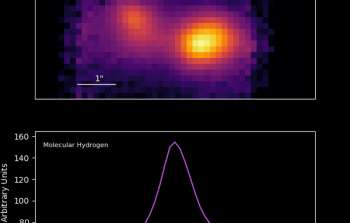sci23055 — Announcement
Gemini North’s New 3D Vision
October 6, 2023
The Gemini Near-Infrared Spectrograph (GNIRS) has been an incredibly productive instrument for the Gemini observatory for the last two decades. Since it was re-commissioned at Gemini North in 2010, GNIRS has had three observing modes: imaging, longslit, and cross-dispersed spectroscopy. This year, through the installation and commissioning of a new low-resolution integral field unit (LR-IFU) provided by Durham University in the UK as part of the Gemini Instrument Upgrade Program, GNIRS gained a powerful observing mode. The LR-IFU optical sub-system reformats the light from a 3.15” x 4.80” rectangular field into a linear pseudo-slit comprising 21 slices each of width 0.15” and length 4.80”. These slices are rearranged in the reduction process into a 3D data cube providing spatially resolved spectroscopy in one band, i.e., X, J, H, or K (short blue camera only) over the entire field of view.
The LR-IFU mode has been offered in the Gemini 2024A call for proposals. This new mode combined with the flexibility of GNIRS in terms of wavelength coverage and resolution (𝜆/Δ𝜆~1700-7200), as well as its compatibility with Gemini’s super seeing mode (LGS + P1), creates a wonderful opportunity for the astronomical community to put on near-infrared 3D glasses and explore a variety of astronomical sources ranging from distant galaxies and their nuclei to solar system objects to everything in between!
A second IFU that will offer higher spatial and spectral resolution (optimized for the Adaptive Optics System ALTAIR) was recently installed on GNIRS. This new high-resolution IFU (HR-IFU) is fully compatible with the Natural Guide Star (NGS) and Laser Guide Star (LGS) modes of ALTAIR, which will result in ~100 mas delivered FWHM and a resolution of up to 𝜆/Δ𝜆~18,000. As with the LR-IFU, observations will provide coverage of a single near-infrared band (X-K) in NGS, LGS, LGS+P1, or natural seeing mode, and will additionally offer capabilities in the L and M mid-infrared bands in natural seeing mode. The HR-IFU is currently undergoing commissioning and it will be offered to the community at a later date.
About the Announcement
| Id: |
ID
sci23055
|

